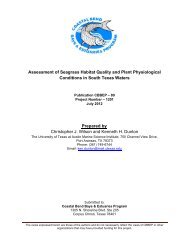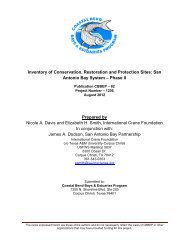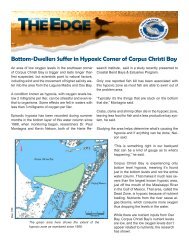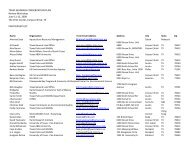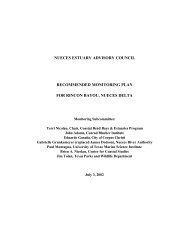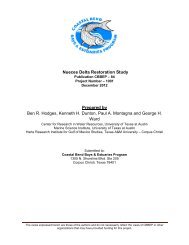Current Status and Historical Trends of Brown Tide and Red Tide ...
Current Status and Historical Trends of Brown Tide and Red Tide ...
Current Status and Historical Trends of Brown Tide and Red Tide ...
- No tags were found...
You also want an ePaper? Increase the reach of your titles
YUMPU automatically turns print PDFs into web optimized ePapers that Google loves.
II. <strong>Historical</strong> trends <strong>of</strong> Texas brown tidesSince the algal species responsible for the Texas brown tide bloom has not beenpreviously described taxonomically, it is difficult to know with certainty if there havebeen previous occurrences <strong>of</strong> the Texas brown tide. Certainly algal blooms haveoccurred in the past in the Laguna Madre, as in any body <strong>of</strong> water. Long time residents<strong>of</strong> south Texas recall periods <strong>of</strong> "brown water" in the Laguna Madre, but it is impossibleto know if the causative organism was the same one present in the current brown tide.Gunter (1945) cites reports <strong>of</strong> “reddish colored ‘bad’ water”, observed by pilots for theTexas Game, Fish <strong>and</strong> Oyster Commission, in Laguna Madre, <strong>and</strong> Simmions (1957)refers to red waters in the Laguna Madre as possibly being caused by: 1) dissolvediron 2) decaying vegetation 3) phytoplankton or 4) clay deposits. None <strong>of</strong> the previousreports seem to compare to the present bloom in either duration or severity.Examination <strong>of</strong> the stable carbon isotope ratios <strong>of</strong> organic carbon from sedimentcores collected in Baffin Bay suggest that the relative importance <strong>of</strong> seagrasses,macrophytic algae <strong>and</strong> phytoplankton may have shifted for decade long periods overthe last several thous<strong>and</strong> years (Parker <strong>and</strong> Scalan, personal communication). Thisalone is not pro<strong>of</strong> that the brown tide organism dominated the Laguna Madre at anypoint in the past, but it does suggest that the relative importance <strong>of</strong> phytoplankton <strong>and</strong>seagrasses as primary producers in Baffin Bay have been different than the patternexisting in historical periods before the brown tide. To determine if the brown tide werethe organism responsible for phytoplankton dominance during these periods,biomarkers specific to the brown tide alga would be needed, <strong>and</strong> cores could beexamined for these compounds. This would require study <strong>of</strong> the diagenesis <strong>of</strong> browntide derived organic material.A. Causative speciesThe organism responsible for this bloom is a small (4-5 µm diameter) phytoplanktonspecies which has not yet been formally classified. Attempts to formally describe thisspecies have recently been completed <strong>and</strong> a species description has been submittedfor publication. The proposed name for this new species is Aureomonas lagunensis (H.DeYoe, personal communication). The Texas "brown tide" alga is devoid <strong>of</strong> obviousexternal diagnostic features when observed by optical microscopy, but examination <strong>of</strong>ultrastructure by transmission electron microscopy <strong>and</strong> <strong>of</strong> photosynthetic pigments byhigh performance liquid chromatography reveal that it is similar in morphology <strong>and</strong>pigments to Aureococcus anophagefferens (Sieburth et al., 1988; Stockwell et al.,1993) which has been responsible for recurrent blooms in Narragansett Bay <strong>and</strong> LongIsl<strong>and</strong> bays since 1985 (Cosper et al., 1987). Recent molecular data indicate that bothspecies belong to a newly recognized class Pelagophyceae (Anderson et al., 1993),but the two species appear to differ enough from one another to warrant placing themin separate genera (DeYoe <strong>and</strong> Suttle, 1995).4



